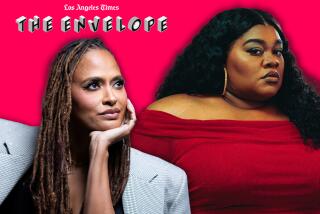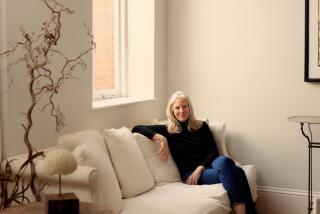ACTRESS, PRODUCER : DUVALL HAPPY WITH HER FAIRY-TALE EXISTENCE
- Share via
Once upon a time, as many fairy tales begin, a little girl dreamed of growing up and becoming a scientist.
“I certainly never thought of having a show business career,” said Shelley Duvall, who has become a successful actress and producer.
“From my first science class in the fourth grade, I wanted to be an Einstein or a Schweitzer. But by the second year of college, I realized I couldn’t stand the sight of blood and I wasn’t much for vivisection, so it was obvious I wasn’t cut out to be a doctor.
“I started getting into smaller areas, like molecules, and I thought I’d go into research.”
However, just as in fairy tales, along came a prince--in this case director Robert Altman--to whisk her away from her scientific studies and lead her into a new life and career by casting her in his 1970 movie, “Brewster McCloud.”
At that point, Duvall had never seen a play, though she does admit that she was somewhat of a film buff.
She made several other films for Altman in the next few years--among them “Brewster McCloud,” “Three Women” and “Nashville”--and in 1980 she was cast as Olive Oyl in his film version of “Popeye,” playing opposite Robin Williams. The movie is generally remembered as something less than a hit, but Duvall remembers it for another reason, because it was during the filming that she got the idea for “Faerie Tale Theater,” her widely praised series for cable television that dramatizes favorite fairy tales.
“I kept thinking Robin would make a perfect frog prince,” she recalled. Williams agreed that a series of fairy tales made for TV with name performers was a good idea and urged her to pursue it.
Originally, she pitched the project to Disney, where she found executives receptive, except that “they wanted to do it their way.” She held out, believing “what’s the use of producing if you don’t end up with what you had in mind?”
Eventually, she went to Showtime. “They liked what I had put together. They were responsive and let me have some creative freedom. It was a good way to get my feet wet and get in on the ground floor of cable,” said Duvall, who is the executive producer of “Faerie Tale Theater” and occasionally appears in the shows.
In its three years on the air, “Faerie Tale Theatre” has turned out such productions as “The Tale of the Frog Prince,” with Williams, Teri Garr and Rene Auberjonois (written and directed by Eric Idle); “Rumplestiltskin,” with Duvall and Ned Beatty; “Hansel and Gretel,” with Joan Collins and Ricky Schroder; “Sleeping Beauty,” with Christopher Reeve, Bernadette Peters and Sally Kellerman; “Little Red Riding Hood,” with Mary Steenburgen and her husband, Malcolm McDowell; “Goldilocks and the Three Bears,” with Tatum O’Neal and Hoyt Axton; “The Princess and the Pea,” with Liza Minnelli; “Snow White and the Seven Dwarfs,” with Elizabeth McGovern, and “Puss & Boots,” with Gregory Hines and Ben Vereen.
In all, 21 “Faerie Tale Theatre” stories have aired, and five new ones are scheduled for next year. Coming this month on Showtime will be “Faerie Tale Theatre’s Greatest Moments,” showing first at 8 p.m. Wednesday, with additional airings July 21, 26 and 29.
Duvall is now involved in another project for Showtime: “Shelley Duvall’s Tall Tales,” hourlong stories based on legendary heroes from American folklore. Clementine, Paul Bunyon and Johnny Appleseed are subjects for the first three shows.
She has decided to play Clementine because . . . well, “she was the daughter of a ‘49er and wore a size-9 shoe . . . so I couldn’t ask anyone to play that.”
With “Tall Tales,” producer Duvall will continue to call on her show business friends to be involved, as she has with the fairy tales.
“I try to cast stars not just because they are stars but because they look good in a role,” she said. And since “Tall Tales” will offer humorous histories, she said that she will be able to use celebrities who might not be right for fairy tales.
Generally, she said, she finds stars like to do her shows. “They do it for their children, and they also like working with us. Even though we’re low-budget by Hollywood standards (each show costs about $500,000, she said), we still know how to treat actors.
“We’re also unusual in that we rehearse five days, then shoot on videotape, mixing film techniques with video, which is perfect for fairy tales because it gives the shows the look of borderline reality.”
Whatever the look, it has caught the attention of young viewers and families as well as organizations that have showered “Faerie Tale Theatre” with praise and awards, including a Peabody Award. The shows have been translated into other languages, and in Japan, she said, they’re used to teach English to children.
Obviously proud of the honors, Duvall commented that much of today’s children’s programming condescends to youngsters. “What do they think kids are, idiots?” she asked.
“Walt Disney once said, ‘I don’t make shows for children; I make shows for everyone,’ and I agree with that,” Duvall said. “I have friends that go to the movies with their children and spend all the time looking at their watches and wondering, ‘When can I get out of here?’
“If a film has a G rating, that means, to a lot of people, don’t bother to see it. But I think all-family entertainment can be just as entertaining to young children as to grandparents. You just have to find a way to include all ages, and humor is the key.”
Looking back, Duvall said her transition from science to show biz wasn’t that difficult. “It’s still chemistry,” she said. “Only now, I’m just putting together human elements and logistics. It’s great fun to see how it all comes together.
“If I hadn’t gotten into show business, I’d probably be working in microbiology or metabolics.”
Instead, she hopes to live happily ever after . . . in filmland.
More to Read
The complete guide to home viewing
Get Screen Gab for everything about the TV shows and streaming movies everyone’s talking about.
You may occasionally receive promotional content from the Los Angeles Times.





